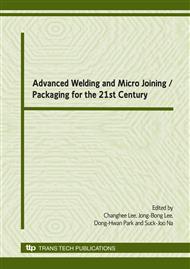p.423
p.427
p.431
p.435
p.439
p.443
p.447
p.451
p.455
Computer Simulation of Residual Stresses in Welding Process Using Finite Element Method
Abstract:
The prediction procedures of the residual stresses in welding process were presented by using finite element techniques. Owing to localized heating by the welding process and subsequent rapid cooling, the residual stresses can arise in the weld itself and in the base metals. The bilinear elastic-plastic material model based on Von Mises yield criterion was developed. The material nonlinearity of weldment and welding fluid was dealt with using an incremental technique. Inside each step, the Newton-Raphson iteration method was utilized. A fully coupled thermo-mechanical twodimensional analysis was performed with finite element method. The model applied in this study adopts the technique of element birth and death to simulate the weld filler variation with time in multi-pass welded joints. The effects of welding speed on residual stresses are discussed.
Info:
Periodical:
Pages:
439-442
Citation:
Online since:
June 2008
Authors:
Price:
Сopyright:
© 2008 Trans Tech Publications Ltd. All Rights Reserved
Share:
Citation:


